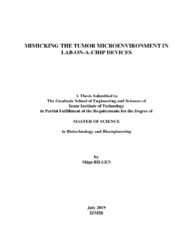Please use this identifier to cite or link to this item:
https://hdl.handle.net/11147/7383| Title: | Mimicking the Tumor Microenvironment in Lab-On Devices | Other Titles: | Yonga-üstü-laboratuvar Aygıtlarında Tümör Mikroçevresinin Taklit Edilmesi | Authors: | Bilgen, Müge | Advisors: | Pesen Okvur, Devrim Sürmeli, Nur Başak |
Keywords: | Breast cancer Tumor microenvironment Extracellular matrix Lab-on-a-chip Extravasation |
Publisher: | Izmir Institute of Technology | Source: | Bilgen, M. (2019). Mimicking the tumor microenvironment in lab-on-a-chip devices. Unpublished master's thesis, İzmir Institute of Technology, İzmir, Turkey | Abstract: | Breast cancer is one of the cancers with the highest incidence and mortality rates
in women in the world. The leading cause of death for cancer patients is tumor metastasis.
Cancer cells can extravasate the blood vessel, go through the distant organs and form the
metastasis. Tumor microenvironment comprises of cancer and normal cells, extracellular
matrix, soluble biological and chemical factors. Biochemical aspects of the interactions
of cancer cells with the constituents of the microenvironment are widely studied whereas
biophysical studies are at limited numbers. There is increasing evidence that extracellular
matrix can change the mechanics and function of cancer and stroma cells. It has been
observed that cancer cells show different responses to soft and stiff tissues they are in
direct contact with than normal cells. New cell culture setups should be developed to
better understand the interactions of cancer cells with their microenvironment.
To develop a three dimensional (3D) in vitro model will allow the study of
stiffness which is one of the mechanical features of extracellular matrix features first, 3D
(dimensional) Controlled in vitro Microenvironments (CivMs) that mimic a blood vessel
and its neighboring tissue in vivo will be fabricated using UV lithography. Monolayer
which was formed by endothelial cells play a role in pathophysiological processes, so it
shows a barrier role between both blood and tissues. To form a blood vessel bEnd.3 cell
line was used. Collagen which is the most abundant protein in connective tissues were
used to mimic extracellular matrix. pH value of collagen was changed and represented
two different stiffness value.
Here, the in vitro model we define as controlled in vitro microenvironments
(CivM) is a lab-on-a-chip (LOC) application. In this microenvironment; MDA-MB-231
cells which are known to be invasive and MCF10A which is normal mammary epithelial
cells were used as control. LOC devices were used to investigate cancer cell extravasation
which is the prominent step of metastasis and extracellular matrix relation. Meme kanseri tüm dünyada kadınlarda en sık rastlanan ve aynı zaman ölüm oranı yüksek olan kanser çeşididir. Kanser hastaları için ilk sırada gelen ölüm sebebi, tümör metastazıdır. Kanser hücreleri damardan çıkarak (ekstravazasyon) birincil organdan farklı organlara giderek metastaz yapmaktadırlar. Tümör mikro çevresi, sağlıklı ve kanserli hücreleri, hücre dışı matriksi, çözünür halde biyolojik ve faktörlerini ve kimyasal etkenleri içerir. Kanser hücrelerinin mikro çevre bileşenleri ile etkileşimlerinin biyokimyasal yönleri yaygın olarak incelenmektedir; fakat biyofiziksel çalışmalar sınırlı sayıdadır. Hücre dışı matriksin kanser ve destek doku hücrelerinin mekaniğini ve işlevlerini değiştirebildiğine dair kanıtlar artmaktadır. Kanser hücrelerinin doğrudan temas halinde oldukları sert ve yumuşak dokulara normal hücrelerden farklı tepkiler verebildikleri de görülmüştür. Kanser hücrelerinin mikro çevreleri ile olan etkileşimlerinin daha iyi anlaşılabilmesi için yeni hücre kültürü düzenekleri oluşturulması gerekmektedir. Ekstravazasyon ile hücre dışı matriksin mekaniksel özelliklerinden biri olan sertliğin incelenmesini sağlayacak üç boyutlu bir in vitro modelin geliştirilmesi için öncelikle UV litografi kullanarak canlıda bir kan damarını ve komşu olduğu dokuyu taklit eden 3B (üç boyutlu) kontrollü in vitro mikro çevreler oluşturulmuştur. Kan damarı dokularla kan arasında bariyer olarak görev alır. Kan damarı oluşturmak için bEnd.3 endotel hücre hattı kullanılmıştır. Bağ dokusunda yüksek miktarda bulunan kolajen hücre dışı matriksi taklit etmek için kullanılmış ve pH değerlerine göre farklı sertlik derecelerine göre ikiye ayrılmıştır. Burada kontrollü in vitro mikro çevre olarak tanımladığımız in vitro model, yonga-üstü-laboratuvar uygulamasıdır. Bu mikro çevrelerde invaziv oldukları bilinen MDA-MB-231 hücreler ile kontrol olarak normal meme epitel hücreleri olan MCF10A kullanılmıştır. Bu çalışmada metastazın önemli basamaklarından olan ekstravazyonun hücre dışı matriksin sertliği ile olan ilişkisi incelenmiştir. |
Description: | Thesis (Master)--Izmir Institute of Technology, Biotechnology, Izmir, 2019 Includes bibliographical references (leaves: 48-56) Text in English; Abstract: Turkish and English |
URI: | https://hdl.handle.net/11147/7383 |
| Appears in Collections: | Master Degree / Yüksek Lisans Tezleri |
Files in This Item:
| File | Description | Size | Format | |
|---|---|---|---|---|
| T001989.pdf | MasterThesis | 2.5 MB | Adobe PDF |  View/Open |
CORE Recommender
Page view(s)
528
checked on Jun 2, 2025
Download(s)
344
checked on Jun 2, 2025
Google ScholarTM
Check
Items in GCRIS Repository are protected by copyright, with all rights reserved, unless otherwise indicated.